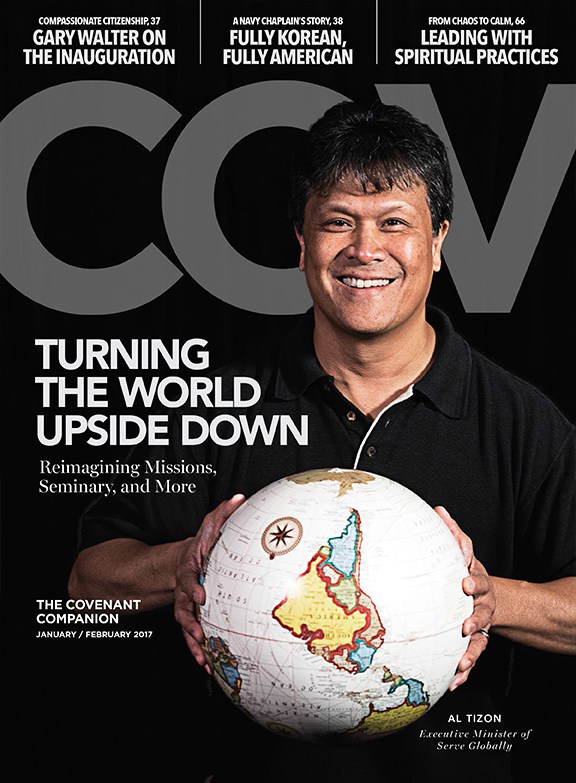OFUNATO, JAPAN (March 10, 2014) — Lack of housing, loneliness, and despair continue to be major concerns for Japan three years after an earthquake and resulting tsunami killed 19,000 people, say leaders of the Japan Covenant Church and Covenant missionary Stephen Bay.
Tuesday will mark the third anniversary of what the Japanese refer to as 3.11, and 267,000 people remain living in temporary structures. The 9.1 magnitude earthquake was the fourth largest in recorded history, but it was the resulting tsunami that wiped out hundreds of miles of coastline, destroyed or damaged one million buildings, and accounted for 95 percent of the death toll.
Government officials have said it will be years before permanent housing can be completed.
For some people, the situation is getting worse. “The long time that people have had to live in temporary housing, the number of people who are suffering from mental stress and dying from loneliness seems to be increasing,” says Yoshinobu Katsumata, who serves as pastor at the Sakawa Covenant Church.
That stress also is affecting children. In Tohuka, one of the areas where the Bays minister, 30 percent of the children have been diagnosed with PTSD.
“In visiting the temporary housing, it is clear that there is much anxiety about the future,” says Keiji Watanabe, chair of the Community Service Committee for the Japan Covenant Church. “New public housing is being built, but the pace is slow and people don’t know when their turn will come.”
“Originally the temporary housing was to be for two years,” Watanabe adds. “That got extended for two more years, but at present there are no plans.”
The anxiety isn’t just about whether new homes will become available, but also about the state of the current housing. “The structures were built to last two years so it is unlikely they will last four years,” Watanabe says.
Transportation continues to be an issue in tsunami-affected areas. “In some ways the Tohoku region (located in the northeast region) has always been somewhat isolated but it seems like now the area has been cut off and is now even more isolated,” says Watanabe. Once accessible by train, Tohuka is now served only by bus.
Stephen Bay and his wife, Soo, are working with the United Project, which was started as a partnership among Japan Covenant Church congregations and the Taiwan Covenant Church to respond to the needs of people following previous earthquakes. The project continues to minister in the Iwate Prefecture, the hardest hit region in the 2011 catastrophe. It now includes an interdenominational network of local churches.
The Bays work out of Grace House in Ofunato, a base funded by the United Project. They reach out to Japanese residents through various means, primarily through putting on events in temporary housing units.
“These events are meant to draw people out of their individual units and spend time in community with each other and with us,” Stephen says. “Events are often centered around arts and crafts, musical performances, or food. Afterward, we have teatime with the attendees.”
Connections are made through the events, and the Bays and other workers from Grace House are able to visit people individually throughout the week. “We bring them gifts that have been donated by other churches and spend time with them,” Stephen says. “Two people have recently accepted Christ through these visits, and we now have the joy and challenge of discipling them.”
People who attend the events tend to be older women, and new efforts are underway to reach out to more men, young adults, and children. Stephen soon will begin teaching children art techniques from his animation background, as well as starting Tai Chi classes for adults, which he hopes will encourage more men to come.
The Ofunato staff also teach English to individuals or small groups for free. The Bays meet weekly with a retired government official, and Stephen regularly meets with a temporary housing unit worker and a group of doctors from Ofunato City Hospital for language exchange.
“Some are visibly traumatized when discussing the disaster of March 2011,” Stephen says.
Local congregations also are ministering to their neighbors. Katsumata tells of a man who “was filled with indescribable fear. He came to the church and put his faith in Jesus.”
The man owns a hairstyling salon, and since his conversion he has traveled the eight hours to Ofunato two to three times a year to cut hair at the communities of temporary housing. There always are long lines, and volunteers engage the people in conversation. “These conversations provide a healing of the heart opportunities,” Katsumata says.
“One woman who had her hair cut said, ‘Wow, it was not just my hair that was lightened, so was my heart,’” Katsumata says.
Watanabe adds that the United Project’s efforts are guided by more than evangelism. “Of course in all that we do we seek to demonstrate the love and grace of God, but we seek to listen to the people affected by the disaster. As long as we don’t lose this perspective, I am convinced that we will continue to see great works of God.”
Volunteers still are needed to help with reconstruction and to minister to individuals. “Compared to just after the tsunami, the number of volunteers has drastically diminished,” says Watanabe. “They are rarely seen. Recently when we visited a couple of shops and let them know that we had come as volunteers to help, they bowed deeply and said, ‘Thank you very much.’ ”
Katsumata says he is grateful for the generosity shown by Covenanters. Much of the work continues to be funded by Covenant World Relief using money donated immediately after the disaster and in the time since.
To give to the ongoing work, click here.
Categories:
News



Thanks for highlighting the needs here in Japan. Three years have passed, but so much remains to be done.